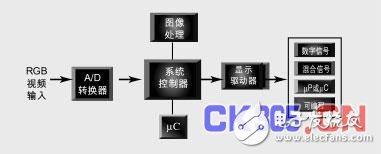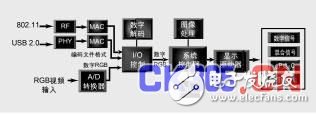Digital video technology is one of the most exciting highlights in today's consumer market. Wireless technology can ensure data encryption and gradually support higher data rates, making it an ideal medium for transmitting video information between different devices. However, there are many standards in this field, which makes improving the flexibility of products and shortening the time to market become the main challenges faced by design engineers. The programmable logic solution integrates various standard interfaces. It can not only ensure the performance of digital video processing and wireless connection, but also solve the problem of interface conversion in wireless transmission of digital video information.
The emergence of digital video technology has become a big joy, and the development of related technologies is as mysterious as opening a "Pandora's Box". In the digital wave of scrambling, different regions, different industries and different suppliers continue to invent new technologies in this field. As a result, numerous standards, formats, rules, specifications and related derivatives have appeared, which makes design engineers feel at a loss , System design engineers face more challenges. Faced with the technologies, formats and standards introduced in digital video, the most important challenge faced by digital video system designers is the risk and complexity of product design. How to design products according to regional differences? How to quickly and efficiently achieve all the required performance? Can a series of configurations be effectively supported to meet the needs of different market levels? The responsibility of the system designer is to ensure the smooth realization of all design goals.
Digital display technology presents some unique challenges to system designers. These challenges include achieving the performance required by the target application, correcting the display characteristics of the specific technology, and generating the drive signal for the target display. A large amount of computing load will cause performance to become the most important challenge in digital display applications, because it is first necessary to achieve a high-bandwidth connection with the signal source.
After the signal is transmitted to the display, a series of complex operations need to be performed on the data, such as decoding from an encrypted transmission format into a pixel map, and optimizing the pixel map for the display. The final data is used to generate display drive signals. What is more difficult is that these processes must be implemented in real time, and the transmission speed of the information data stream must range from about 25Mbps (streaming HDTV) to 1.5Gbps (original uncompressed 1080i HDTV display data).

Pipeline optimization is also a problem. The digital image data must fit the characteristics of the specific target display technology. These are all based on similar chromatic principles, but they all have their own unique and non-linear display behavior characteristics. Therefore, RGB data (usually for CRT display) must be processed to display acceptable display effects on LCD, PDP or other displays. This processing may be as simple as color correction, or it may include more algorithms to achieve scaling, contrast adjustment, brightness control, gradient smoothing, edge enhancement and image enhancement, which requires sufficient processing power.
The challenge at the back end of the pipeline is that the display driver circuit processes the image data and physically drives the screen. This step will generate a series of signals and distribute them to drive each individual pixel. The format of these driving signals changes with different technologies, has strict timing requirements, and their specifications are unique for each model of display. In the case of digital projectors, traditional products accept analog RGB video inputs, process the data appropriately, and then drive the projection display. This is usually achieved through some analog (blue), digital (black) and control (green) components, as shown in Figure 1.

With the development of digital integration, new products may support direct digital input in certain formats, and may support receiving and displaying encoded file formats. In this case, the designer is faced with the difficult choice of which input and format to support? Then the appropriate components must be selected and integrated to achieve such a choice in the design and meet the performance requirements. Figure 2 shows a design example that supports fast 802.11 WLAN connections. The engineer may ask: How to implement new logic in the system controller to process new data?? In order to integrate new components, what interface and signal standards are needed? What kind of user interface and control software need to be developed?
Since the 802.11b, 802.11a and HiperLAN2 specifications define non-standard interfaces and require interfaces with digital displays and other video products, programmable logic has naturally become an ideal solution to the interface problem. Generally speaking, programmable logic devices are flexible and development platforms are efficient, which can speed up development progress. In addition, FPGAs are extremely cost-effective, making them a viable product solution.
Figure 3 shows a digital integrated projector solution based on FPGA. It can be seen that an FPGA (shown in maroon) and related logic is added between the A/D converter and the existing system controller. In this design, FPGA plays the role of I/O arbitration, accepting input from all three signal sources.
When such a connection is active, the digital RGB simply flows through. However, in the case of USB 2.0 and 802.11b, the FPGA completely manages these new interfaces and decodes the input data stream into a digital RGB format. Because FPGA supports some high-speed interfaces, each other component (memory, ASSP, etc.) can be flexibly selected. FPGAs also make it possible to interface with future wireless standards (such as 802.11a and HiperLAN2) and existing wired interfaces (such as Ethernet and IEEE1394).
FPGA can be completely independent or appropriately using an ASIC or ASSP to realize functions such as encoding/decoding and image processing (represented by black/maroon modules). FPAG also supports numerous encryption/decryption standards such as AES, DES, triple DES and some special types. At present, there is no solid standard for the decryption of streaming media files, and the existing standards are also very different due to differences in regions and content providers. Using programmable devices as decryption engines can support users' current and future needs.
As the core of the display drive circuit, the programmable logic design can support two or more display options. It is of great significance in the following aspects: controlling the cost of expensive components; supporting a series of products based on a common core design to expand the market; LVDS can be used on the circuit board (usually may lead to crossing a large number of circuit board areas) to route signals, And minimize the impact of system-level EMI and noise on critical signals.

FPGAs are also particularly suitable for designing unique and attractive user interfaces. They are true GPIOs. In today's fierce market competition, user interfaces have become one of the most effective ways to differentiate products from competitors. FPGAs provide the greatest freedom for innovation in this field.
In addition, programmable logic will not delay the design progress for countless design iterations. This may become its unique advantage when integrating new and unfamiliar technologies. After the design is completed, the product can be quickly released and quickly put into production. When unavoidable design and incompatibility problems occur, the system can be quickly resolved and the on-site equipped system can be quickly upgraded, thus greatly reducing support and service costs. If the user needs a new feature, a different performance, or a new configuration, it can be implemented quickly and effectively with the help of FPGA. If faced with a supply problem of system components during the production process, FPGA can also be used as an alternative solution to ensure timely delivery of the product.
In short, the portability, mobility and ease of use of equipment have become the driving force for the development of wireless transmission technology for digital video information. With the continuous improvement of wireless technology data rate and QoS, the dream of wireless video will eventually become a reality. However, there are still some design challenges when integrating various wireless interface technologies in digital systems. Programmable logic devices provide interfaces to other components, decoding/encoding, image processing and encryption/decryption functions, as well as fast time to market and design flexibility. Sex, etc. can sometimes help design engineers solve the problems they face
Nantong Boxin Electronic Technology Co., Ltd. , https://www.ntbosen.com
![<?echo $_SERVER['SERVER_NAME'];?>](/template/twentyseventeen/skin/images/header.jpg)